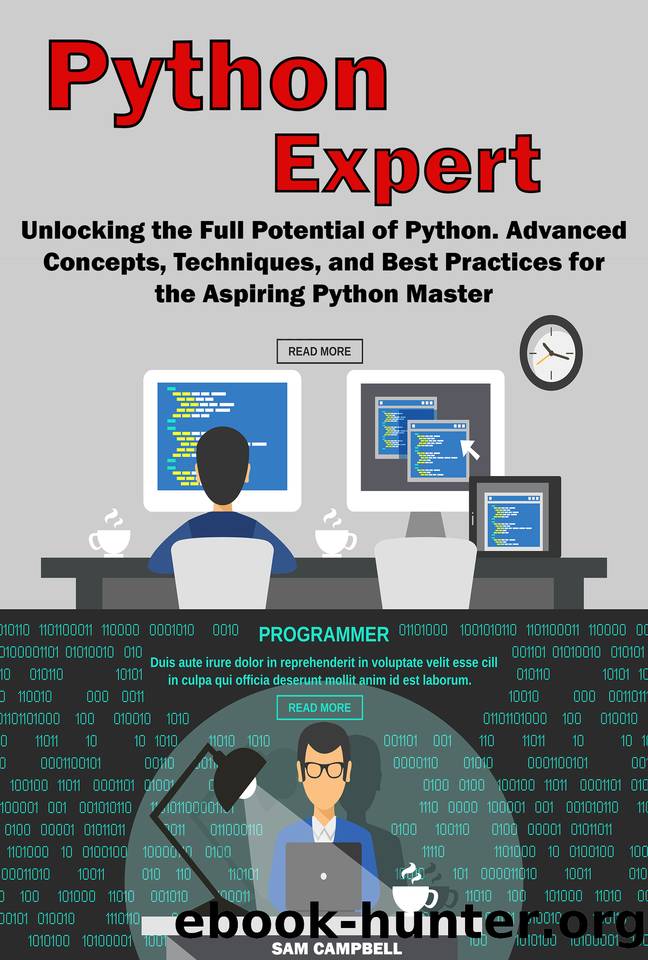Python Expert: Unlocking the Full Potential of Python. Advanced Concepts, Techniques, and Best Practices for the Aspiring Python Master by CAMPBELL SAM

Author:CAMPBELL, SAM
Language: eng
Format: epub
Published: 2024-01-30T00:00:00+00:00
Choosing Between Beautiful Soup and Scrapy
The choice between Beautiful Soup and Scrapy should be based on the scale and complexity of the scraping task at hand. For simple, one-off scripts to extract data from a single page or a small set of pages, Beautiful Soup is often the easiest way to get up and running quickly. Its simplicity and the ability to integrate seamlessly with Python's other HTTP libraries like requests make it an excellent choice for beginners and for tasks that don't require the full power of a web crawling framework.
For more complex scraping tasks, especially those that involve crawling multiple pages or entire websites, Scrapy is the better tool for the job. Its built-in functionality for handling various aspects of web scraping and its efficient asynchronous architecture make it suitable for tasks that require high performance and extensive data extraction.
Both Beautiful Soup and Scrapy are powerful tools for web scraping in Python. The choice between them depends on the specific requirements of your project, the complexity of the web scraping task, and your personal or team's familiarity with the libraries.
Automation Scripts for Everyday Tasks
Automation scripts play a crucial role in enhancing productivity and efficiency by automating repetitive and mundane tasks that are part of daily routines in both personal and professional settings. With the advancement of scripting languages, particularly Python due to its simplicity and versatility, automating everyday tasks has become accessible to a broader audience, including those who may not have a strong programming background. These scripts can range from simple file organization tasks to more complex workflows involving data processing, web scraping, or even automating emails and social media interactions.
One of the most common uses of automation scripts is for file management. Many individuals and businesses deal with a vast amount of data daily, leading to cluttered and unorganized directories. Automation scripts can help by sorting files into designated folders, renaming them according to a specific pattern, or automatically deleting files that are no longer needed. For instance, a Python script can monitor a download folder and sort files into music, documents, images, and videos based on their file extension, significantly reducing manual file management.
Another powerful application of automation scripts is in data processing and report generation. Businesses often need to generate reports from data stored in spreadsheets or databases. An automation script can extract this data, perform necessary calculations or transformations, and generate a report in a fraction of the time it would take to do manually. This not only speeds up the decision-making process but also minimizes the risk of human error.
Web scraping is yet another area where automation scripts shine. Whether it's for market research, monitoring competitor prices, or aggregating news from various sources, scripts can automatically retrieve information from websites at scheduled intervals. This information can then be processed and analyzed, providing valuable insights without the need for manual data collection.
Email automation is also highly beneficial, especially for those who need to send out similar emails to multiple recipients regularly. Scripts can personalize emails for each recipient and send them out automatically, saving hours of work.
Download
This site does not store any files on its server. We only index and link to content provided by other sites. Please contact the content providers to delete copyright contents if any and email us, we'll remove relevant links or contents immediately.
| AI & Machine Learning | Bioinformatics |
| Computer Simulation | Cybernetics |
| Human-Computer Interaction | Information Theory |
| Robotics | Systems Analysis & Design |
Algorithms of the Intelligent Web by Haralambos Marmanis;Dmitry Babenko(16237)
Jquery UI in Action : Master the concepts Of Jquery UI: A Step By Step Approach by ANMOL GOYAL(9389)
Test-Driven Development with Java by Alan Mellor(7737)
Data Augmentation with Python by Duc Haba(7610)
Principles of Data Fabric by Sonia Mezzetta(7380)
Learn Blender Simulations the Right Way by Stephen Pearson(7296)
Microservices with Spring Boot 3 and Spring Cloud by Magnus Larsson(7139)
Hadoop in Practice by Alex Holmes(6589)
RPA Solution Architect's Handbook by Sachin Sahgal(6519)
The Infinite Retina by Robert Scoble Irena Cronin(6217)
Big Data Analysis with Python by Ivan Marin(5937)
Life 3.0: Being Human in the Age of Artificial Intelligence by Tegmark Max(5518)
Pretrain Vision and Large Language Models in Python by Emily Webber(4896)
Infrastructure as Code for Beginners by Russ McKendrick(4654)
Functional Programming in JavaScript by Mantyla Dan(4438)
WordPress Plugin Development Cookbook by Yannick Lefebvre(4386)
The Age of Surveillance Capitalism by Shoshana Zuboff(4250)
Embracing Microservices Design by Ovais Mehboob Ahmed Khan Nabil Siddiqui and Timothy Oleson(4149)
Applied Machine Learning for Healthcare and Life Sciences Using AWS by Ujjwal Ratan(4136)
